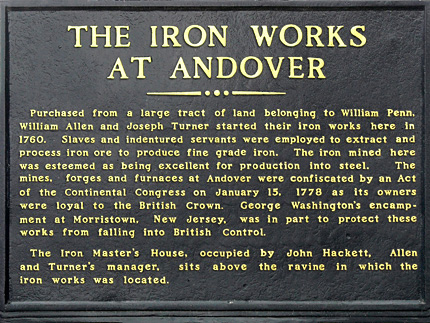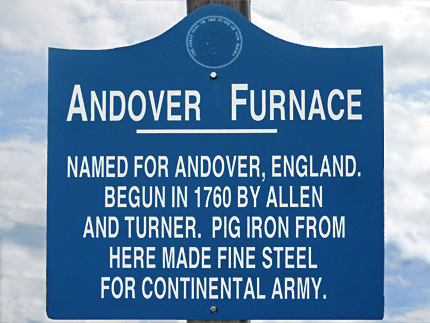




The Iron Master's House
Private residence. Please respect the property and privacy of the owners.

The Grist Mill
Now a commercial space used by Petit Points Interiors
Andover Iron Works Site
Main St (Rte. 206) and Grist Mill Ln.
Map / Directions
Andover Iron Works [1]
The Andover Iron Works were known for the high quality of iron they produced. Its property spread out over many miles. The iron for the operation was supplied from mines which were located about two miles north from here on the east side of Limecrest Ave. [2] Once obtained, the iron ore was then melted down at a furnace located at this site.
The next phase in the iron process occurred at Andover forge, which was located about five miles to the south, at what is now Waterloo Village in Byram Township. At the forge the iron was refined and hammered "into rods, bars or plates that smiths could work into horseshoes, gun barrels, nails, tools, agricultural implements, cutlery and tire iron." [3]
The Iron Master's house which housed the manager of the iron works was located near the furnace. The house still stands here on Main Street with an "Iron Works at Andover" historic sign on the front lawn. Nearby on Grist Mill Lane stands a building that was originally a grist mill which was used to grind flour for feeding men who worked for the Iron works.
William Allen and Joseph Turner, who founded the Andover Iron Works, were British Loyalists, who early in the war they fled to behind British lines. Later, on January 15, 1778, the Continental Congress ordered the confiscation of the Andover Iron Works, which were then used to produce goods for the American army. [4] Allen and Turner also owned the Union Iron Works in Hunterdon County. [5]

1. ^ Much of the information for this entry was drawn from:
Kevin W. Wright, A History of the Andover Ironworks: Come Penny, Go Pound (Charleston, London: The History Press, 2013)2. ^ Photos of the remains of the Andover iron mines can be found on the Iron Miners website.
3. ^ Kevin W. Wright, A History of the Andover Ironworks: Come Penny, Go Pound (Charleston, London: The History Press, 2013) Page 47
4. ^ Journals of Congress: Containing the Proceedings from Sept. 5, 1774 to November 3, 1788 (Philadelphia: 1800) Page 26
Available to be read at the Internet Archive here5. ^ For more information about the Union Iron Works, see the Clinton, Hampton, and High Bridge pages of this website.